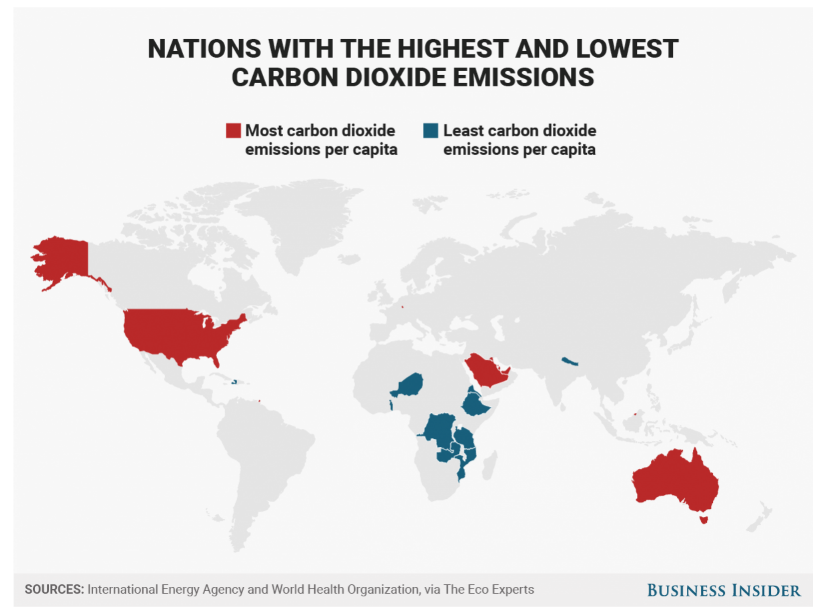The best - and worst - countries for air pollution and electricity use

Air pollution levels vary widely around the world.
Image: REUTERS/Edgar Su - RTX1LA7D
Stay up to date:
Decarbonizing Energy
China steals an unsavory global spotlight for the thick, noxious smog that often chokes its mega-cities.
Air pollution has become so bad in Beijing, for example, that Chinese officials aim to slash its local coal consumption by 30% in 2017.
Meanwhile, the US — which currently ranks eighth on the list of countries with the lowest air pollution — could be headed in the opposite direction.
President Donald Trump has said that he intends to fulfill his campaign promise of revitalizing the American coal industry, despite the criticism of fossil fuel industry analysts and the rise of affordable sources of renewable energy. Congress is also working to repeal numerous environmental and health regulations.
With these and other changes afoot, it's worth taking a look at current global rankings to see how China, the US, and other countries stack up when it comes to air quality, total energy use, and renewable contributions to power production.
Here the best and worst of 135 countries according to World Health Organization (WHO) and International Energy Agency data, which was shared with Business Insider by The Eco Experts, a UK-based solar energy comparison site.

There are many ways to measure air pollution, but a key indicator is called "PM 2.5" — one of the most harmful classes of airborne pollutants.
The "PM" stands for "particulate matter," and the "2.5" stands for 2.5 microns in diameter or smaller — roughly the size of a single bacterium. Such pollution, as Business Insider's Lydia Ramsey explained in 2016, "is especially dangerous because it can get lodged in the lungs and cause long-term health problems like asthma and chronic lung disease."
When PM 2.5 levels go above roughly 35 micrograms per cubic meter of air, it can become a major health problem. The WHO recommends keeping PM 2.5 levels to about 10 micrograms per cubic meter.
While Chinese cities have recently hit more than 500 micrograms of PM 2.5 per cubic meter, Saudi Arabia, on a per-country average, has the most toxic air in the world.


Air pollution levels are one thing, but deaths attributed to them are another.
Take China, for instance. The country isn't in the top 10 for highest average levels of air pollution, in terms of PM 2.5 (Saudi Arabia wins that contest, thanks in part to its oil industry). However, it ranks fifth for having the most deaths per capita due to air pollution, in part because if its high population density.
The US currently has one of the lowest death rates attributed to air pollution.


Decades of scientific investigation across multiple lines of evidence corroborate a powerful yet inconvenient truth: Human-caused global warming and climate change is real, and it's briskly accelerating as we dump more carbon into the atmosphere.
Looking at per-person average emissions of carbon dioxide, a persistent greenhouse gas emitted by burning fossil fuels, the US ranks as the eighth-highest contributor in the world.
Less developed nations, which lack robust and power-hungry infrastructure, rank among the lowest contributors to carbon dioxide emissions.


The main reason the US ranks so poorly on carbon dioxide emissions is because its per-person consumption rate of electricity is so high; all of that energy comes primarily from fossil fuels.
As with carbon dioxide emission rankings, less developed nations tend to score better on electricity consumption because access to electrical power is not as widely available.

Don't miss any update on this topic
Create a free account and access your personalized content collection with our latest publications and analyses.
License and Republishing
World Economic Forum articles may be republished in accordance with the Creative Commons Attribution-NonCommercial-NoDerivatives 4.0 International Public License, and in accordance with our Terms of Use.
The views expressed in this article are those of the author alone and not the World Economic Forum.
Related topics:
Forum Stories newsletter
Bringing you weekly curated insights and analysis on the global issues that matter.
More on Nature and BiodiversitySee all
David Elliott
June 19, 2025
Jean-Claude Burgelman and Lily Linke
June 18, 2025
Georgina Mondino and Maximiliano Frey
June 18, 2025
Forum Stories
June 17, 2025
Lindsay Hooper
June 16, 2025
Swapan Mehra and Akim Daouda
June 16, 2025





